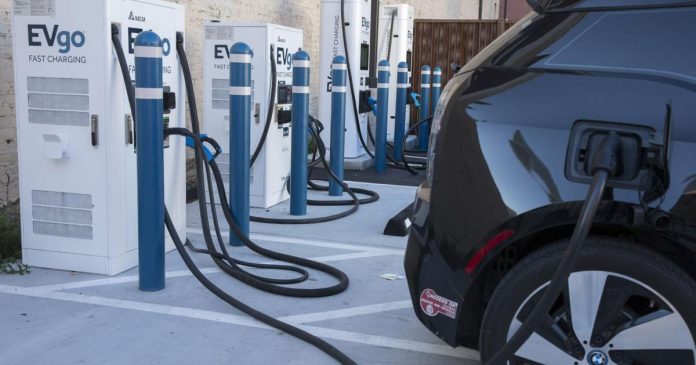When it comes to electric vehicles, we may have put the car before the charging infrastructure. Zero- and low-emission vehicles are considered a crucial part of how the United States will transition away from fossil fuels — and the Bay Area is leading the way with about one in four new cars whirring off dealership lots with a battery instead of a gas tank.
But in densely packed cities like San Francisco, questions about where to charge and whether Pacific Gas & Electric’s infrastructure can support the future strain on the grid remain unanswered.
Despite recent mandates that would outfit new construction and crowded parking lots with charging stations and legislation to streamline the planning code, the EV infrastructure in San Francisco and other Bay Area cities has lagged behind.
This has caused competition for plugs and occasional waits for charging stations across The City, especially among those who can’t charge at home.
“We know that the demand for public charging is going to or has already outpaced the supply of charging stations,” said Lowell Chu, interim program manager of energy and clean transportation at the San Francisco Department of Environment.
There are now over 820 public EV charging stations in San Francisco, said Chu, but this number is set to rapidly increase in the coming years as The City moves to fully realize its EV Roadmap.
“The intent is to effectuate that build-out of the public charging network,” said Chu. “By 2030, all new vehicles should be electric — 100% electric. And by 2040, everything that moves should be electric — because the transportation sector is responsible for half of all our greenhouse gas emissions. Half.”
The City plans to install 5,000 chargers by 2030, in line with San Francisco’s emissions reduction targets. It’s a tall order, but help from both federal and state funding is on the way.
This week, the Senate voted to pump billions of dollars toward speeding up the transition to clean energy, with a healthy share allocated to the transportation sector. The Inflation Reduction Act, which heads to the House for a vote on Friday, would funnel money to electric car purchases over the next decade, including a $7,500 tax break for new electric vehicles.
Although who and what kinds of cars qualify for these credits have sparked some debate, the goal is to make EVs accessible to people across income levels, policymakers assert.
But even as chargers crop up in more places, new research shows that California’s grid may not be ready to accommodate the flurry of EVs and infrastructure required to keep pace with consumer demand and the state’s climate targets.
“Is the system capable of meeting current energy needs? The answer is certainly yes,” said Duncan Callaway, professor of energy and resources at UC Berkeley and an author of the study. But, he said, “the pace of circuit upgrades will need to triple between now and 2030 to meet the goals California has for electrification.”
Callaway estimates that those upgrades could cost PG&E up to $10 billion. But it’s not the money that worries him — it’s the pace of change. Right now, PG&E estimates that one in five EVs in the U.S. charge from its grid. But that could swiftly shift as the demand for electric vehicles continues to grow.
“If all customers in PG&E’s service territory overnight purchased electric vehicles, nearly every circuit would need to get upgraded,” said Callaway. “PG&E’s workforce needs to be able to absorb this new shock of projects,” he said, adding his research shows that it will be tricky for the utility to do so at its current pace.
“Utilities have an enormous task,” said Justin Wilson, director of public policy at ChargePoint, an EV charging network started in 2007. “What we’re doing with electric vehicle charging is taking an entire sector — the liquid fuels-based sector — and moving it onto the electrical grid. We need to be real that this is going to require grid upgrades.”
But this issue is top of mind for utilities like PG&E. The company said it’s committed to providing programs and incentives to help redefine the energy landscape through building grid capacity while also exploring second-life battery programs, autonomous EVs, and other technologies that would support California’s clean air and greenhouse gas emission reduction goals.
Meeting The City’s climate targets will also require people to think beyond cars. Chu noted that 80% of trips taken would need to transition to low-carbon alternatives like walking, biking and taking public transit by 2030 — and that doing so will help reduce the demand on the grid.
While the future of EV charging in San Francisco poses many questions, it also represents an opportunity to rethink how we get around and what’s powering our movement through our city.
And when it comes to charging up, “We want to be as convenient as filling up a tank of gas,” said Chu.

